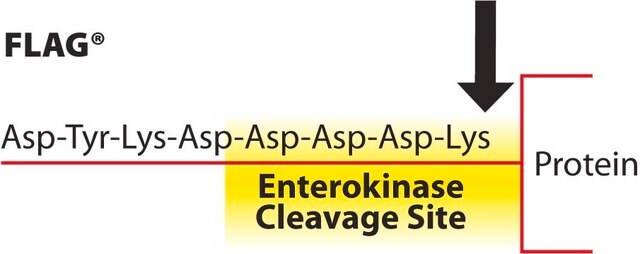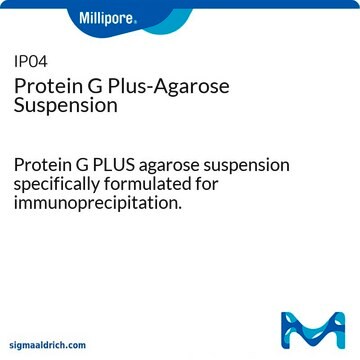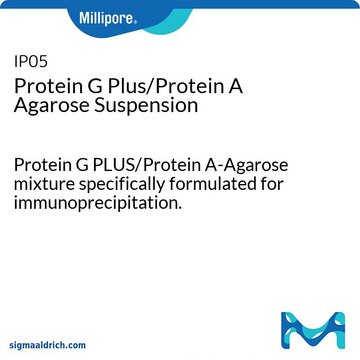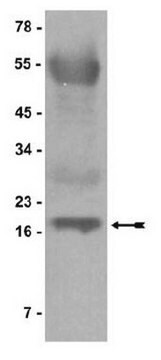Alle Fotos(1)
Wichtige Dokumente
PROTGA-RO
Roche
Protein G-Agarose
>98% (HPLC and SDS-PAGE), suspension
Synonym(e):
Agarose, Protein G
Anmeldenzur Ansicht organisationsspezifischer und vertraglich vereinbarter Preise
Alle Fotos(1)
About This Item
UNSPSC-Code:
41116133
Empfohlene Produkte
Assay
>98% (HPLC and SDS-PAGE)
Form
suspension
Verpackung
pkg of 15 mL (05015952001 [settled resin volume])
pkg of 2 mL (11719416001 [settled resin volume])
pkg of 5 mL (11243233001 [settled resin volume])
Hersteller/Markenname
Roche
Lagertemp.
2-8°C
Allgemeine Beschreibung
Protein G wurde ursprünglich aus einem menschlichen Gruppe-G-Streptokokkenstamm (G148) isoliert. Es ist ein Zellwandprotein mit hoher Affinität zum IgG (Immunglobulin G). Es hat ein mutmaßliches Molekulargewicht von 30.000 Da. Es interagiert mit allen Unterklassen des menschliche IgG und bindet auch an Maus-, Kaninchen- und Ziegen-IgG.
Spezifität
Protein G ist ein aus einem bestimmten Bakterienstamm isoliertes Zellwandprotein, das spezifische Bindungsstellen für bestimmte Klassen von Immunglobulinen verschiedener Spezies aufweist. Protein G bindet an fast alle IgG-Unterklassen, aber an keine anderen Klassen von Immunoglobulinen.
Bindungskapazität: 20 mg menschliches IgG (polyklonal)/ml (das IgG wird bei einem pH-Wert von 7,0 beladen und mit 200 mM Glycin, pH 2,8, eluiert)
Struktur: rekombinantes Protein G (E. coli, Mr = 22.000) wird kovalent an quervernetzte 4%ige Agarose-Beads gekoppelt: 2,5 mg Protein G (>98 % rein)/1 ml Gel.
Bindungskapazität: 20 mg menschliches IgG (polyklonal)/ml (das IgG wird bei einem pH-Wert von 7,0 beladen und mit 200 mM Glycin, pH 2,8, eluiert)
Struktur: rekombinantes Protein G (E. coli, Mr = 22.000) wird kovalent an quervernetzte 4%ige Agarose-Beads gekoppelt: 2,5 mg Protein G (>98 % rein)/1 ml Gel.
Anwendung
Affinitätschromatographie mit Protein-G- sowie Protein-A-Agarose ist die bevorzugte Methode für die Aufreinigung der IgG vieler Spezies. Es wird als Vorreinigungsmittel verwendet bei
- Ubiquitination-Assays
- Immunpräzipitation
Leistungsmerkmale und Vorteile
Inhalt
Vorgequelltes Gel, gebrauchsfertig, 2 ml oder 5 ml Gel (abgesetztes Gelvolumen) in einem Puffer, der 14 - 19 % Ethanol als Konservierungsmittel enthält, nicht steril.
Protein G Inhalt: 2,5 mg/ml vorgequelltes Gel
Vorgequelltes Gel, gebrauchsfertig, 2 ml oder 5 ml Gel (abgesetztes Gelvolumen) in einem Puffer, der 14 - 19 % Ethanol als Konservierungsmittel enthält, nicht steril.
Protein G Inhalt: 2,5 mg/ml vorgequelltes Gel
Qualität
Reinheit: >98 % (HPLC, SDS-PAGE); vollkommen frei von Staphylokokken-Enterotoxinen.
Sonstige Hinweise
Nur für die Life-Science-Forschung. Nicht für den Einsatz in diagnostischen Verfahren geeignet.
Signalwort
Warning
H-Sätze
Gefahreneinstufungen
Eye Irrit. 2 - Flam. Liq. 3
Lagerklassenschlüssel
3 - Flammable liquids
WGK
WGK 1
Flammpunkt (°F)
102.2 °F
Flammpunkt (°C)
39 °C
Hier finden Sie alle aktuellen Versionen:
Besitzen Sie dieses Produkt bereits?
In der Dokumentenbibliothek finden Sie die Dokumentation zu den Produkten, die Sie kürzlich erworben haben.
Kunden haben sich ebenfalls angesehen
Yijiao Ning et al.
Frontiers in oncology, 12, 937716-937716 (2022-10-18)
Aberrant protocadherins (PCDHs) expression trigger tumor invasion and metastasis. PCDH20 anti-tumor functions in various tumor have been identified. Tumor suppression is due to Wnt/β-catenin pathway antagonism and may be suppressed caused by PCDH20 downregulation through promotor methylation, whereas PCDH20 effects
Jakob Triebel et al.
European journal of endocrinology, 161(2), 345-353 (2009-05-30)
In vitro experiments and in vivo studies on rodents demonstrate that N-terminal 14, 15, 16, 17, and 18 kDa fragments prolactin-related vasoinhibin (PRL-V) of human PRL are natural inhibitors of neovascularization in the retina and elsewhere. These N-terminal PRL fragments
T-H Kim et al.
Cell death & disease, 5, e1527-e1527 (2014-11-21)
Understanding the molecular networks that regulate adipogenesis is crucial for combating obesity. However, the identity and molecular actions of negative regulators that regulate the early development of adipocytes remain poorly understood. In this study, we investigated the role of CREB3L4
R Travis Taylor et al.
Methods (San Diego, Calif.), 55(2), 166-171 (2011-08-23)
Ubiquitin (Ub) conjugation to a substrate protein is a widely used cellular mechanism for control of protein stability and function, modulation of signal transduction pathways and antiviral responses. Identification and characterization of ubiquitinated viral proteins is an important step in
L Björck et al.
Journal of immunology (Baltimore, Md. : 1950), 133(2), 969-974 (1984-08-01)
Protein G, a bacterial cell wall protein with affinity for immunoglobulin G (IgG), has been isolated from a human group G streptococcal strain (G148). Bacterial surface proteins were solubilized by enzymatic digestion with papain. Protein G was isolated by sequential
Global Trade Item Number
| SKU | GTIN |
|---|---|
| 5015952001 | 4061832422589 |
| 11243233001 | 4061838250896 |
| 11719416001 | 4061838251039 |
Unser Team von Wissenschaftlern verfügt über Erfahrung in allen Forschungsbereichen einschließlich Life Science, Materialwissenschaften, chemischer Synthese, Chromatographie, Analytik und vielen mehr..
Setzen Sie sich mit dem technischen Dienst in Verbindung.















